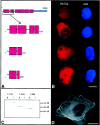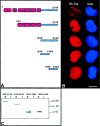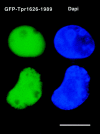Functional analysis of Tpr: identification of nuclear pore complex association and nuclear localization domains and a role in mRNA export
- PMID: 9864356
- PMCID: PMC2175216
- DOI: 10.1083/jcb.143.7.1801
Functional analysis of Tpr: identification of nuclear pore complex association and nuclear localization domains and a role in mRNA export
Abstract
Tpr is a 270-kD coiled-coil protein localized to intranuclear filaments of the nuclear pore complex (NPC). The mechanism by which Tpr contributes to the structure and function of the nuclear pore is currently unknown. To gain insight into Tpr function, we expressed the full-length protein and several subdomains in mammalian cell lines and examined their effects on nuclear pore function. Through this analysis, we identified an NH2-terminal domain that was sufficient for association with the nucleoplasmic aspect of the NPC. In addition, we unexpectedly found that the acidic COOH terminus was efficiently transported into the nuclear interior, an event that was apparently mediated by a putative nuclear localization sequence. Ectopic expression of the full-length Tpr caused a dramatic accumulation of poly(A)+ RNA within the nucleus. Similar results were observed with domains that localized to the NPC and the nuclear interior. In contrast, expression of these proteins did not appear to affect nuclear import. These data are consistent with a model in which Tpr is tethered to intranuclear filaments of the NPC by its coiled coil domain leaving the acidic COOH terminus free to interact with soluble transport factors and mediate export of macromolecules from the nucleus.
Figures











References
Publication types
MeSH terms
Substances
Grants and funding
LinkOut - more resources
Full Text Sources
Molecular Biology Databases

